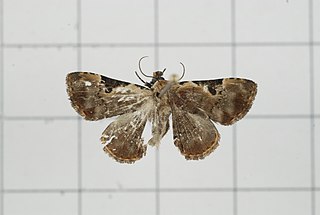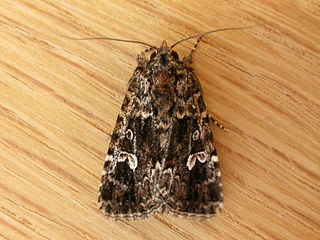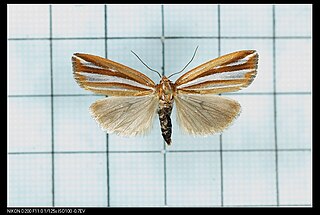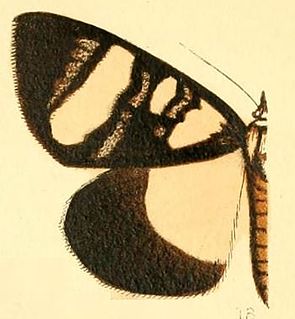Related Research Articles
Asteropetes is a monotypic moth genus of the family Noctuidae erected by George Hampson in 1901. Its only species, Asteropetes noctuina, was first described by Arthur Gardiner Butler in 1878. It is found on the Kuriles and in Japan.
Cremnophora is a monotypic moth genus of the family Noctuidae erected by George Hampson in 1901. Its only species, Cremnophora angasii, was first described by George French Angas in 1847. It is found in South Australia.

Diomea is a genus of moths of the family Erebidae erected by Francis Walker in 1858.

Ectopatria is a genus of moths of the family Noctuidae. The genus was erected by George Hampson in 1903.

Eutrichopidia is a genus of moths of the family Noctuidae. The genus was erected by George Hampson in 1901.
Lophonotidia is a genus of moths of the family Noctuidae. The genus was erected by George Hampson in 1901.

Loxioda is a genus of moths of the family Erebidae. The genus was described by Warren in 1913.

Narangodes is a genus of moths of the family Noctuidae. The genus was erected by George Hampson in 1910.
Neocerynea is a monotypic moth genus of the family Noctuidae erected by George Hampson in 1918. Its only species, Neocerynea sabulosa, was first described by Schaus in 1901. It is found in Mexico.

Omphaloceps is a genus of moths of the family Noctuidae. The genus was erected by George Hampson in 1901.
Paraegocera is a genus of moths of the family Noctuidae. The genus was erected by George Hampson in 1901.
Parothria is a monotypic moth genus of the family Noctuidae erected by George Hampson in 1901. Its only species, Parothria ecuadorina, was first described by John O. Westwood in 1877. It is found in Ecuador.

Platyja is a genus of moths of the family Erebidae erected by Jacob Hübner in 1823.
Polacanthopoda is a genus of moths of the family Noctuidae. The genus was erected by George Hampson in 1901
Pseudophisma is a genus of moths of the family Erebidae. The genus was erected by George Hampson in 1926.

Rivula is a genus of moths in the family Erebidae described by Achille Guenée in 1845.
Schalifrontia is a monotypic moth genus of the family Noctuidae. Its only species, Schalifrontia furcifer, is found in the Brazilian state of Santa Catarina. Both the genus and species were first described by George Hampson in 1901.
Holocraspedon bilineata is a moth of the family Erebidae first described by George Hampson in 1901. It is found in Singapore, Thailand and the north-eastern Himalayas, as well as on Peninsular Malaysia, Borneo, Sulawesi and Sumbawa. The habitat consists of lowland forests and wet heath forests.
Heosphora is a genus of moths in the family Pyralidae. The genus was first described by Edward Meyrick in 1882. The type species is Anerastia psamathella Meyrick, 1879, designated as such by George Hampson in 1901. All Heosphora species are found in Australia.
Heosphora minimella is a species of moth in the family Pyralidae. The species was first described by George Hampson in 1901. It is found in Australia.
References
- ↑ Beccaloni, G.; Scoble, M.; Kitching, I.; Simonsen, T.; Robinson, G.; Pitkin, B.; Hine, A.; Lyal, C., eds. (2003). "Phasidia". The Global Lepidoptera Names Index . Natural History Museum . Retrieved December 3, 2020.
- ↑ Savela, Markku (September 9, 2019). "Phasidia Hampson, 1901". Lepidoptera and Some Other Life Forms. Retrieved December 3, 2020.
- ↑ Pitkin, Brian & Jenkins, Paul (November 5, 2004). "Phasidia Hampson, 1901". Butterflies and Moths of the World. Natural History Museum, London . Retrieved December 3, 2020.
| This Agaristinae article is a stub. You can help Wikipedia by expanding it. |